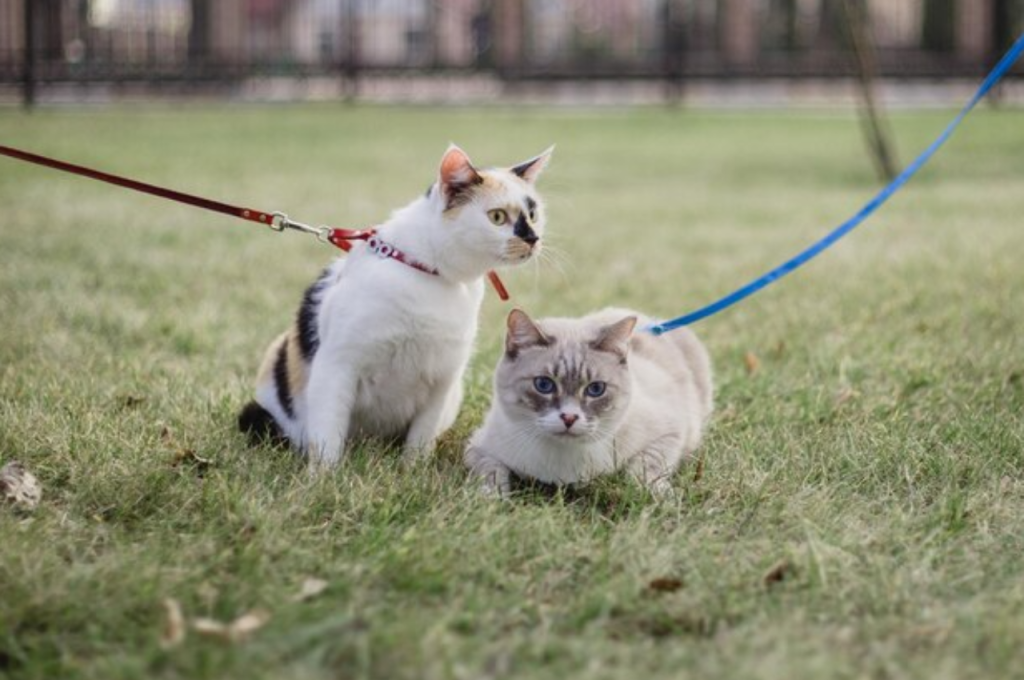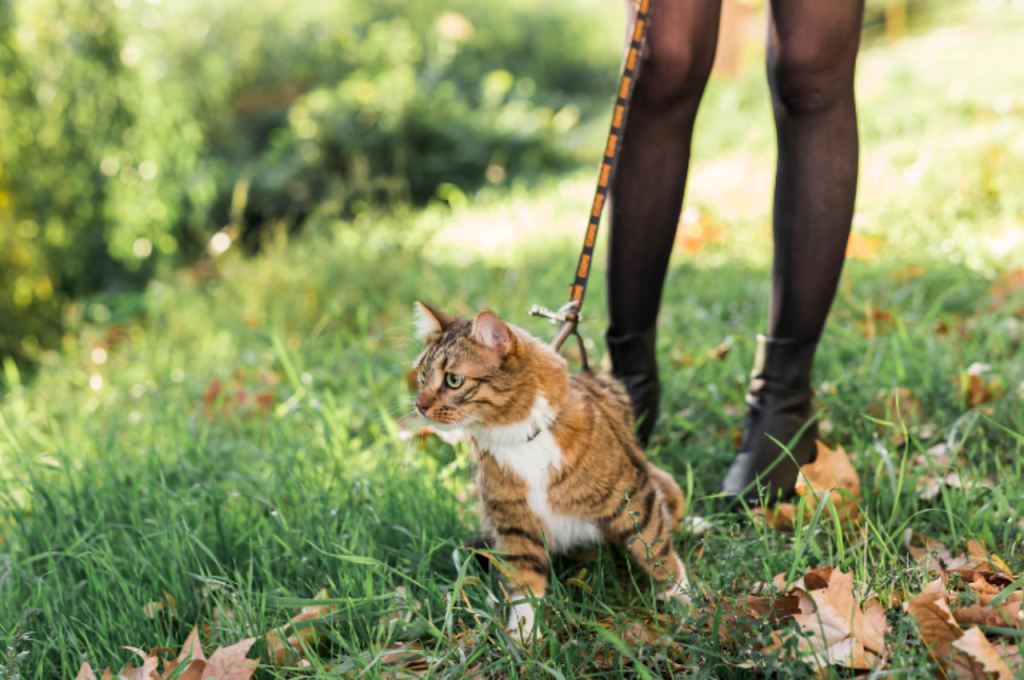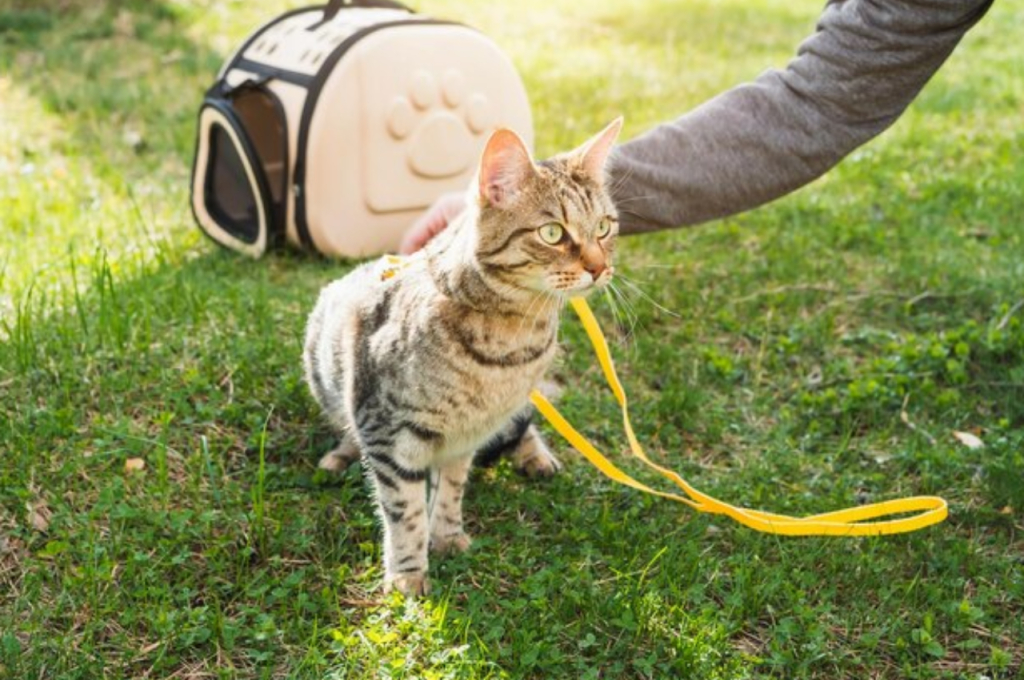To train a cat to walk on a leash, start indoors, and get the cat used to wearing the harness. Then, attach the leash and let the cat explore indoors. Next, move to a quiet outdoor area, and let the cat explore at its own pace.
Keep initial sessions short and stress-free, allowing your cat to gradually adapt to the new experience. Offer treats and positive reinforcement for calm behavior, rewarding your cat for each step taken. Gradually increase the outdoor time while ensuring the environment is safe and free from potential stressors. Always allow your cat to lead the way and maintain a calm, patient approach throughout the process. Remember, patience is key in training cats to walk on a leash, and progress may take time.
Introduction to Leash Training Cats
Leash training a cat can be an enriching experience for both you and your feline friend. While it may seem unusual, many cats can be trained to walk on a leash, allowing them to explore the outdoors safely. The process begins with selecting a comfortable, well-fitting harness designed specifically for cats. Start by introducing the harness indoors, letting your cat become familiar with its feel. Gradually, attach the leash and encourage short walks around the home, rewarding your cat with treats and praise. With patience and positive reinforcement, leash training can help your cat enjoy new environments while staying secure and under your control.

Misconceptions About Cats on Leashes
Many people believe that cats can’t be trained to walk on a leash, but with the right approach and patience, it’s entirely possible to teach your feline friend to enjoy outdoor adventures safely.
Benefits of Leash Training
Leash training can provide numerous benefits for both cats and their owners. It allows cats to explore the outdoors safely, providing mental and physical stimulation while also strengthening the bond between the cat and their owner.
Choosing The Right Equipment
When it comes to training your cat to walk on a leash, choosing the right equipment is crucial for a successful and enjoyable experience. Proper gear not only ensures your cat’s comfort and safety but also makes the training process easier. In this guide, we will explore the essential factors to consider when selecting the right harness and leash for your feline companion.
Types of Cat Harnesses
There are various types of harnesses designed specifically for cats. The two most common styles are vest harnesses and figure-eight harnesses. Vest harnesses wrap around the cat’s body and distribute pressure evenly, while figure-eight harnesses loop around the neck and chest, providing a secure fit. It’s important to choose a harness that offers a balance between comfort and control, ensuring that your cat can move freely while remaining safely restrained.
Selecting a Leash
When selecting a leash for your cat, opt for a lightweight and durable material such as nylon or cotton. Retractable leashes can provide flexibility during walks, allowing your cat to explore while maintaining a controlled distance. Ensure that the leash is long enough to allow freedom of movement but not too long to pose a safety risk. Additionally, consider the hardware of the leash, ensuring that it is secure and easy to fasten.
Comfort and Safety Considerations
- Ensure the harness fits snugly but not too tight
- Inspect for any potential choking hazards
- Choose a leash length appropriate for your cat’s size and behavior
- Opt for a lightweight and non-restrictive design
- Regularly check for wear and tear to prevent breakage
Preparation for Training
Prepare to train your cat to walk on a leash by starting indoors. Begin with introducing the harness and leash gradually, allowing your cat to get comfortable with wearing them. Use positive reinforcement, such as treats and praise, to encourage your cat to associate the leash with positive experiences. Gradually progress to short outdoor walks to help your cat acclimate to the new experience.
Creating a Positive Environment
Before training your cat to walk on a leash, it’s crucial to create a positive and comfortable environment. Choose a quiet area in your home where your cat feels safe and secure. Ensure that the training sessions are free from distractions. Make the training area appealing by placing your cat’s favorite toys, blankets, and treats. This will help your cat associate the training area with positivity and enjoyment.
Introducing The Harness and Leash
Gradually introduce your cat to the harness and leash. Allow your cat to sniff and investigate the harness before attempting to put it on. Ensure that the harness fits snugly but is not too tight. A comfortable fit is essential for your cat’s mobility and comfort during walks. Once your cat is comfortable with the harness, attach the leash and let your cat roam around indoors while supervised. This will help your cat get used to the sensation of the leash without feeling overwhelmed.
Initial Harness Training
Train your cat to walk on a leash with initial harness training. Start by getting your cat used to wearing a harness indoors, then gradually introduce the leash. Use treats and positive reinforcement to create a positive association with the harness and leash.
Getting Your Cat Comfortable
To get your cat comfortable with initial harness training, start by introducing the harness in a calm and familiar environment. Allow your cat to sniff and explore the harness at its own pace, offering treats and gentle praise to create a positive association. Gradually place the harness on your cat for short periods, ensuring it is snug but not too tight. Reward your cat with treats, affection, or playtime while wearing the harness to build comfort and trust. Repeat this process daily, gradually increasing the time your cat wears the harness until they become accustomed to it. Patience and consistency are key to successful harness training.
Building Positive Associations
Building positive associations is crucial during initial harness training for your cat. Begin by allowing your cat to explore and sniff the harness, rewarding them with treats and gentle praise to create a positive connection. Gradually introduce the harness by placing it on your cat for short periods, increasing the duration as they become more comfortable. Pair the harness with enjoyable activities, like playtime or treats, to reinforce a positive experience. By taking these small, rewarding steps, you help your cat feel safe and confident, making harness training a more enjoyable process for both of you.
Leash Training Indoors
Train your cat to walk on a leash indoors with these simple steps. Start by introducing the leash gradually and rewarding positive behavior. Use treats and patience to help your feline friend become comfortable with leash training.
Guiding Your Cat with Treats
When leash training your cat indoors, treats can be a valuable tool to guide them in the right direction. Use a treat to lure your cat towards you, rewarding them with praise and another treat when they reach you. This positive reinforcement can help them associate walking on the leash with a positive experience.
Short Sessions for Success
Training your cat to walk on a leash can take time and patience, so it’s important to keep sessions short and sweet. Start with just a few minutes at a time, gradually increasing the length of each session as your cat becomes more comfortable. Remember to always end each session on a positive note, with plenty of praise and treats for your furry friend. In addition to these tips, it’s important to choose the right type of leash and harness for your cat’s size and personality. A harness that fits securely but comfortably will help your cat feel more at ease while walking on the leash. Overall, leash training your cat can be a fun and rewarding experience for both you and your furry friend.
By using treats, keeping sessions short and sweet, and choosing the right equipment, you can help your cat become a pro at walking on a leash in no time.
Walking Techniques and Commands
Train your cat to walk on a leash with these effective techniques and commands. Teach them step by step, using positive reinforcement and patience to ensure a successful and enjoyable walking experience together. Walking Techniques and Commands are the key to successfully training your cat to walk on a leash. Before you start training, ensure your cat is comfortable wearing a harness and leash. Here are some essential techniques and commands to teach your cat to walk on a leash.

Basic Commands to Teach
Start with basic commands such as “come” and “stay”. Use treats as a reward and repetition to reinforce these commands. Your cat should be able to follow these commands before you start leash training.
How to Lead and Follow
When walking your cat, lead them with the leash while using a calm and reassuring voice. Allow your cat to take the lead and follow them at their pace. Avoid pulling on the leash, as this can cause stress and discomfort for your cat.
Walking Techniques
Start with short walks in familiar areas to get your cat used to the leash. Gradually increase the distance and duration of walks. Use positive reinforcement, such as treats and praise, to encourage good behavior. Always be patient and avoid forcing your cat to do something they are not comfortable with. Training your cat to walk on a leash takes time, patience, and consistency. Focus on teaching basic commands, leading and following techniques, and positive reinforcement. With practice, your cat will become comfortable walking on a leash and enjoy exploring the great outdoors with you.
Troubleshooting Common Issues
To troubleshoot common issues when training a cat to walk on a leash, start by introducing the harness gradually. Encourage positive reinforcement through treats and patience to help your feline companion adjust comfortably to the leash-walking experience. Remember to keep training sessions short and enjoyable for your cat.
Training your cat to walk on a leash can be a challenging process, and it’s common to encounter issues along the way. Here are some tips to help you troubleshoot common issues and ensure a successful training experience.
Dealing with Resistance
If your cat is resisting the leash, try these techniques:
- Start with short training sessions and gradually increase the time spent on the leash.
- Use treats and positive reinforcement to encourage your cat to walk on the leash.
- Try using a harness instead of a collar, as some cats find collars uncomfortable.
- Ensure your cat has plenty of space to roam and explore, as this can help them feel more comfortable on the leash.
Addressing Fear and Anxiety
If your cat is fearful or anxious while on the leash, try these techniques:
- Start by introducing your cat to the leash indoors, where they feel safe and comfortable.
- Use treats and positive reinforcement to encourage your cat to associate the leash with good things.
- Take things slow and don’t push your cat too far too quickly.
- Consider using calming aids such as pheromone sprays or calming collars.
- If your cat is still fearful or anxious, consult with your veterinarian for additional guidance and support.
With these tips and techniques, you can troubleshoot common issues and help your cat become comfortable and confident on a leash. Remember to be patient, and persistent, and always use positive reinforcement to encourage good behavior.
Advanced Training and Exploration
Embark on an exciting journey with advanced training and exploration to teach your feline friend how to walk on a leash effortlessly. Discover the art of leash training for cats and enjoy outdoor adventures together like never before.
Expanding Your Cat’s Comfort Zone
In advanced training, gradually expand your cat’s comfort zone. Encourage exploration in a familiar environment. Introduce new sounds and textures to pique curiosity.
Safe Exploration Tips
Supervise your cat closely during outdoor adventures. Avoid busy streets and crowded areas. Teach your cat to respond to voice commands. Use a comfortable harness and leash designed for cats. Incorporate play and positive reinforcement techniques. Remember to reward good behavior with treats. Ensure your cat’s safety at all times. Keep outdoor sessions short and enjoyable. Provide a safe retreat if your cat gets scared. Regularly check for signs of discomfort or stress.
Maintaining and Enjoying The Walks
Train your cat to walk on a leash and enjoy leisurely strolls together. Discover effective techniques and tips to maintain a safe and enjoyable walking routine for you and your feline friend.
Training your cat to walk on a leash is a great way to provide exercise, fresh air, and mental stimulation for your feline friend. However, it’s important to maintain a regular schedule and routine to ensure that your cat is comfortable and happy during walks. Additionally, incorporating fun activities while on leash can make walks more enjoyable for both you and your cat.
Regular Schedule and Routine
Cats thrive on routine, so it’s important to establish a regular schedule for walks. Try to schedule walks at a time when your cat is most active and alert, such as early morning or late afternoon. Start with short walks and gradually increase the duration and distance over time. Consistency is key, so try to stick to the same walking route and avoid sudden changes to the routine.
Fun Activities While on Leash
Walking on a leash can be a new and exciting experience for cats, so incorporating fun activities can make walks more enjoyable. Bring along toys or treats to play with during breaks, or allow your cat to explore new environments and smells. You can also try incorporating training exercises, such as teaching your cat to sit or come when called. These activities will not only keep your cat engaged but also strengthen the bond between you and your feline companion. In conclusion, maintaining a regular schedule and routine, as well as incorporating fun activities, are key to ensuring that your cat enjoys walking on a leash. With patience and persistence, you and your cat can enjoy the outdoors together.
Health and Safety Tips
Teaching your cat to walk on a leash can be a fun and safe way to explore the outdoors together. Follow these helpful tips to train your cat effectively: start indoors, use positive reinforcement, introduce the harness gradually, practice short sessions, be patient, and reward your cat’s progress. Enjoy the bonding experience while keeping your feline friend safe!
Monitoring Your Cat’s Health
- Regularly check your cat’s weight and overall well-being.
- Look for signs of fatigue or unusual behaviors.
- Observe their eating and drinking habits.
- Monitor their litter box usage.
Safety Precautions for Outdoor Adventures
- Use a properly fitted harness for your cat.
- Keep vaccinations up-to-date before going outside.
- Avoid busy roads and crowded areas.
- Stay vigilant of potential dangers like other animals.
Building a Bond Through Leash Training
Build a strong bond with your cat through leash training. It’s a gradual process that requires patience and positive reinforcement. With consistent training, your cat can learn to walk on a leash, allowing you to enjoy outdoor adventures together.

The Joys of Walking Your Cat
Walking your cat on a leash is a great way to provide mental and physical stimulation while strengthening the bond between you and your feline friend. It allows your cat to explore the outdoors in a safe manner, enriching their lives with new sights, sounds, and smells. The experience can be immensely rewarding for both you and your cat, creating precious memories and fostering a deeper connection.
Encouragement for Persistent Training
Leash training a cat requires patience and consistency. It’s essential to remain encouraging and positive throughout the process. Celebrate small victories and provide plenty of praise and rewards to reinforce good behavior. With determination and perseverance, your cat can learn to enjoy walking on a leash, leading to an enriching and fulfilling experience for both of you.
Conclusion
Training a cat to walk on a leash can be a rewarding experience for both you and your feline companion. By following the steps outlined in this guide, you can gradually introduce your cat to the leash, use positive reinforcement, and create a safe and enjoyable walking routine. Remember to be patient, consistent, and understanding of your cat’s individual personality and needs. With time and practice, you can successfully train your cat to walk on a leash and explore the great outdoors together.
